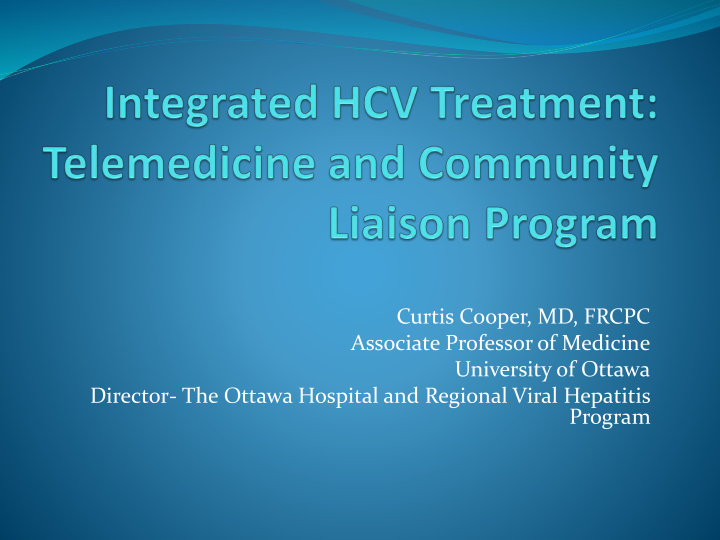



Curtis Cooper, MD, FRCPC Associate Professor of Medicine University of Ottawa Director- The Ottawa Hospital and Regional Viral Hepatitis Program
Disclosures Presenter: Curtis Cooper Relationships with commercial interests Grants/Research support: ABV, GS, MK Speakers Honoraria: ABV, GS, MK, BMS Consulting Fees: ABV, GS, MK Other: OHTN, U Ottawa
Collaborative Efforts to Manage HCV: Telemedicine
Telemedicine Use of telecommunication and information technologies with the goal of providing clinical health care to distant or isolated individuals. Can eliminate distance barriers and improve medical services access that otherwise would not be available.
Parmvir Parmar, David Mackie, Sunil Varghese, Curtis Cooper. The Use of Telemedicine Technologies in the Management of Infectious Diseases: A Review. Clinical Infectious Diseases 2015
Telemedicine at TOH Over 150 TOH TM users, over 400 patients seen/month Mixed model of regular clinic / ad hoc visits Over 20 clinical services Videoconferencing available to any TOH physician at any TOH campus Scheduling support is offered by the telemedicine office
Benefits of Telemedicine Telemedicine technology has the ability to overcome many barriers for accessing health care in a timely manner: remote communities with travel hardships economic barriers immobile patients limited availability of specialists comprehensive referral information
TOHVHP Building Community Capacity for HCV Care and Cure Program The overall objective is to develop community based expertise in HCV care and treatment in Cornwall, Pembroke, Smith Falls, Renfrew and Hawkesbury and Nunavut Territory. Other in-need communities will be added as required. The specific goals are: Increase the number of health care personnel providing HCV care Increase the number of patients with HCV monitored by local health providers Increase the number of patients with HCV treated To ensure that HCV care and treatment is equivalent to care provided at the TOHVHP
Building Community Capacity for HCV Care and Cure Timelines and Project Flow: Metrics April 2015 – Present Apr May Jun Jul Aug Sept Oct Nov Dec Jan Feb Mar Ongoing TOHVHP Telemedicine Program Ongoing Partner Identification: CME events in target communities Ongoing Partner Training at the TOHVHP Ongoing Onsite Partner Training x x x x Case Based Discussion Sessions Ongoing Data Collection x x x x Interim Analysis and Outcome Evaluation Ongoing Knowledge Translation and Exchange
TOHVHP Telemedicine Stats Overall Consults (Jan - Sept 2015) 78 referrals (5-16 / month) 300+ participants 50+ patients treated / on-treatment Sites Cornwall x 20 2015 Hawkesbury x 8 260 patients seen Renfrew x 7 30 on treatment Smith Falls x 4 Arnprior x 4 Perth, Almonte, Kemptville, Pembroke, Athens, South Mountain, Carleton Place, Carp, Morrisburg, Brockville, Prescott, Pettawawa, Williamsburg, Constance Bay (West Locations x 1-2 / site) Vankleek Hill, Alfred, Akwasasne , Alfred, Alexandria, Crylser (East x 1 or 2) North Bay, New Lisgard, Iqualuit , Thunder Bay (North x 1 each) Fibroscan 4 blitzs Education 1 CME 2 lunch and learns for nurses
Ottawa TM Assessment A cohort database analysis was performed on patients followed at TOHVHP between Jan 2012 and Aug 2016. Patients older than 18 years of age and those infected with chronic HCV were included. TM (n=174) and non-TM (n=2162) patients were compared by examining baseline characteristics and clinical outcomes. Data was collected using charts and electronic medical records in TOHVHP database.
Results TM patients were more likely to be Indigenous (7.0% vs 2.2%), GT3 infected (25.9% vs 16.4%), and to have a history of IDU (70.1% vs 54.9%), alcohol use (69.4% vs 56.9%), and incarceration (46.5% vs 35.5%). Similar in age (mean 48.9), gender (63.7% male) and cirrhotic stage (24.0%). The length of HCV infection was shorter in TM patients (2o.7 years vs 26.7 years). TM patients were less likely to be HIV co-infected (0.6% vs 6.6%) and more likely to have material deprivation (31.8% vs 17.0%). TM patients were less likely to be biopsied (15.9% vs 39.2%) and less likely to initiate IFN- based treatment. TM patients were equally likely to undergo Fibroscan and to initiate DAA-based treatment. DAA SVR rate in the TM group was 94.7% and 94.8% in the non-TM group (p=0.995). Indigenous population, and Genotype 3 associated with less likelihood of achieving SVR.
Conclusions Our TM program successfully engages and retains a remote population exhibiting characteristics that are associated with barriers to successful HCV treatment. Fibroscan technology and DAA-based treatments have helped to enable these outcomes. TM patients were able to engage in HCV care, achieving high SVR rates comparable to those obtained by Outpatient Clinic care.
Challenges No shows / Lost to Follow-Up Engaging all Marginalized Groups Patient Deterioration Laboratory Results Medication Funding Staffing turnover Identifying partners Engaging trainees Assessment Evaluation questionnaires Maintaining dataset
Lessons Learned Can be done Highly dependent on the staff responsible for the role Need a solid understanding of staff role and HCV Need to determine way to determine who is serious about training and who is trainable
Collaborative Efforts to Manage HCV: Community Liaison Program
Acknowledgement Patients TOH Viral Hepatitis Program Team Ministry of Health Audience
Recommend
More recommend